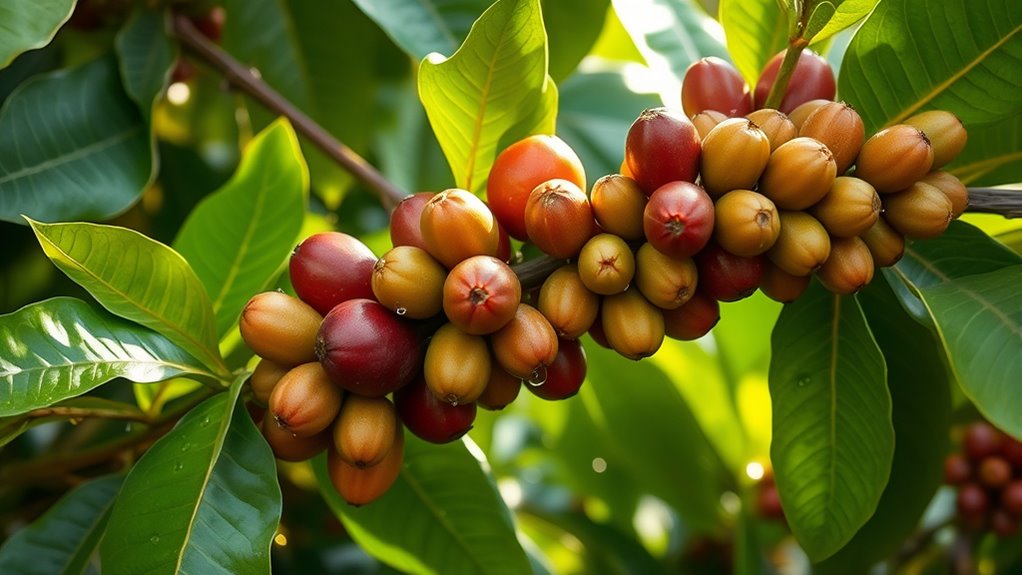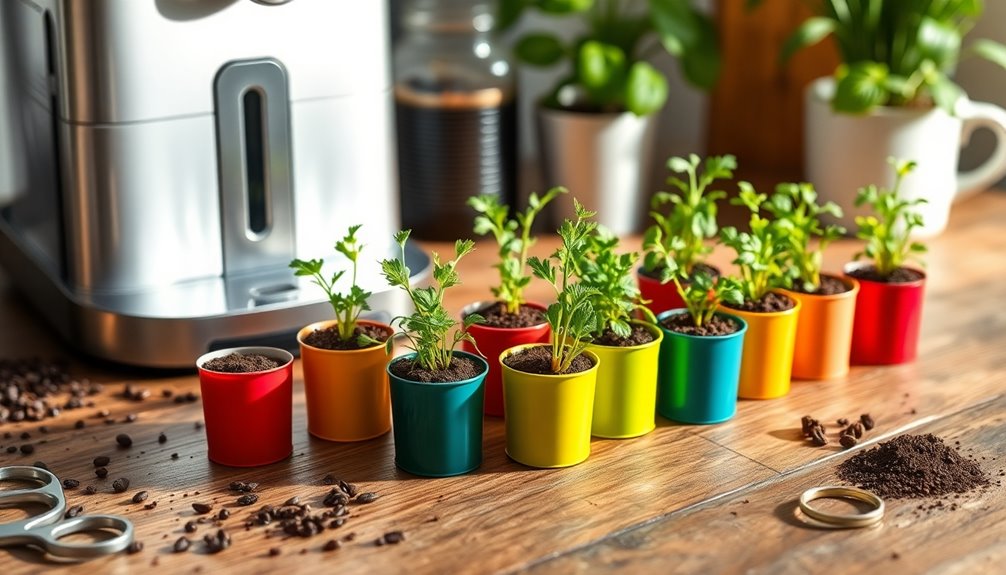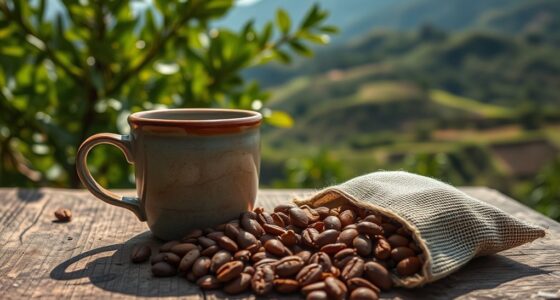Liberica and Excelsa are two lesser-known coffee species that are returning to prominence among coffee lovers. Known for their unique and bold flavors, these varieties thrive in tropical climates and offer a rich history that sets them apart from Arabica and Robusta. Their distinctive aromas and tastes are gaining recognition in specialty markets, appealing to those seeking something different. Keep exploring to discover more about these extraordinary coffee options and what makes them stand out.
Key Takeaways
- Liberica and Excelsa are increasingly recognized in specialty coffee markets for their unique flavors.
- Both species are experiencing a resurgence due to growing consumer interest in diverse coffee profiles.
- Cultivation techniques are being refined to optimize quality and expand their cultivation regions.
- Their distinctive woody, fruity, and floral notes set them apart from traditional Arabica and Robusta.
- These “forgotten” species offer rich histories and traditional practices, appealing to connoisseurs seeking novelty.

Have you ever wondered about the lesser-known coffee species beyond Arabica and Robusta? If so, you’re not alone. While Arabica and Robusta dominate the global market, Liberica and Excelsa are gaining recognition for their unique qualities and rich histories. These coffee varieties have been largely overshadowed, but recent interest is bringing them back into the spotlight. As a coffee enthusiast, exploring these species opens up a whole new world of flavors and cultivation methods that can deeply enhance your appreciation for coffee’s diversity.
Liberica coffee, native to West Africa and Southeast Asia, offers a distinctive experience. Its cultivation techniques differ markedly from those of Arabica and Robusta, often requiring specific climate conditions and careful harvesting. Liberica plants thrive in humid, tropical environments, and their cultivation demands attention to detail to produce quality beans. The flavor profiles of Liberica are equally remarkable—bold, woody, and fruity with a hint of floral notes. These characteristics make Liberica stand out, providing a complex cup that appeals to those seeking something different from the usual smoothness of Arabica or the robustness of Robusta.
Excelsa, a variety once classified as a distinct species but now considered a subspecies of Liberica, is primarily cultivated in Southeast Asia. Its cultivation techniques share similarities with Liberica but are tailored to its unique growth habits. Excelsa plants favor higher elevations and specific soil conditions, which influence the way they’re cultivated and harvested. Once processed, Excelsa reveals a flavor profile that’s intriguingly tart and fruity, often with hints of dark berries and a slight spiciness. This makes Excelsa a versatile coffee that can add complexity and depth to blends or stand out in single-origin brews.
Both Liberica and Excelsa are making a comeback because coffee connoisseurs are enthusiastic to explore new taste horizons. Their cultivation techniques, though more demanding than traditional varieties, are increasingly being refined by farmers looking to diversify their crops. As a result, these species are slowly re-entering specialty coffee markets. For you, this means a chance to taste coffees with distinctive aroma and flavor profiles that challenge conventional expectations. Whether brewed as a pour-over or espresso, Liberica and Excelsa offer a rich sensory experience rooted in history and tradition, promising a journey into coffee’s lesser-known but equally fascinating world.
Frequently Asked Questions
Are Liberica and Excelsa Suitable for Home Cultivation?
Yes, Liberica and Excelsa can be suitable for home gardening if you’re willing to learn specific cultivation techniques. You’ll need to provide ample space, well-draining soil, and a warm climate to mimic their native environments. Regular watering and proper pruning help guarantee healthy growth. Keep in mind that these species might be more demanding than common coffee plants, but with patience, you can successfully cultivate them at home.
What Are the Unique Flavor Profiles of Liberica and Excelsa Coffee?
Imagine tasting a symphony of flavors with each sip. Liberica offers tasting notes of fruity, floral, and woody notes, creating a rich, complex experience. Excelsa surprises your palate with dark, spicy, and tart nuances, adding depth and intrigue. Both species boast flavor complexity that stands out from typical coffees, inviting you to explore their unique profiles and discover new, compelling sensations with every cup.
How Do Liberica and Excelsa Trees Differ From Arabica and Robusta?
You’ll notice Liberica and Excelsa trees differ from Arabica and Robusta in their genetic makeup, influencing flavor and growth habits. Liberica has a unique genetic profile with larger beans and a distinct aroma, while Excelsa’s genetics give it a tart, fruity flavor. Their cultivation techniques also vary; Liberica and Excelsa often thrive in specific climates and require different care, making them less common but increasingly valued for their unique qualities.
What Are the Main Challenges in Restoring Liberica and Excelsa Populations?
Restoring Liberica and Excelsa populations is like rebuilding a delicate tapestry; you face challenges such as limited genetic diversity and habitat preservation. You need to protect their native environments and guarantee diverse genetic pools to boost resilience. Without these efforts, their populations could thin out again. It’s essential you focus on restoring native habitats and promoting genetic health, or these unique coffee species might become a fading memory.
Can Liberica and Excelsa Adapt to Climate Change?
Yes, Liberica and Excelsa can adapt to climate change through genetic adaptation and building climate resilience. You can support their adaptation by promoting diverse planting practices and protecting natural habitats. These species have inherent resilience, but your efforts in conservation and sustainable cultivation are crucial. By fostering genetic diversity, you help guarantee they can withstand changing temperatures and weather patterns, securing their future in the face of climate challenges.
Conclusion
Now, as Liberica and Excelsa make their comeback, you realize they’re more than just forgotten species—they’re treasures in disguise. While Arabica and Robusta dominate your morning brew, these lesser-known beans offer a richer, more complex flavor profile. It’s a surprising twist, proving that sometimes, what’s been overlooked holds the greatest potential. So, next time you sip your coffee, consider embracing these rare varieties—they could redefine your entire coffee experience.










